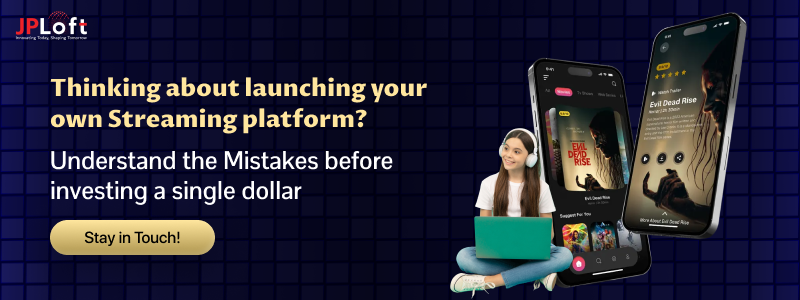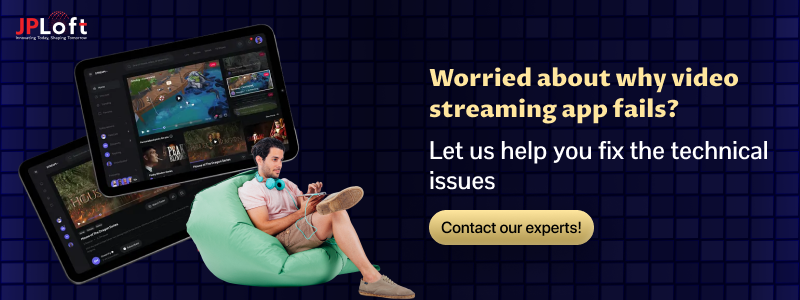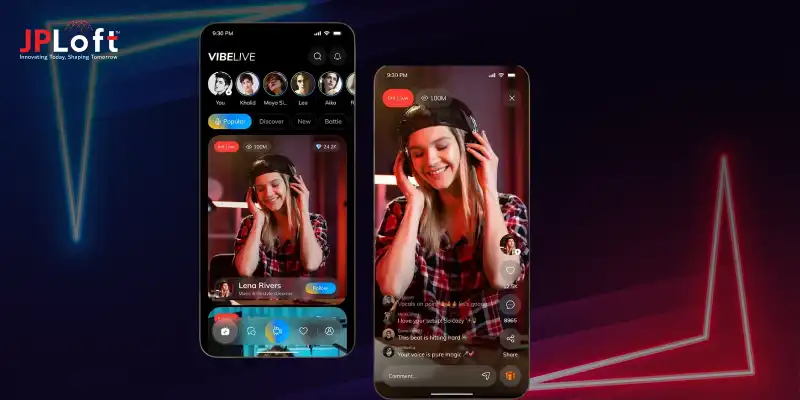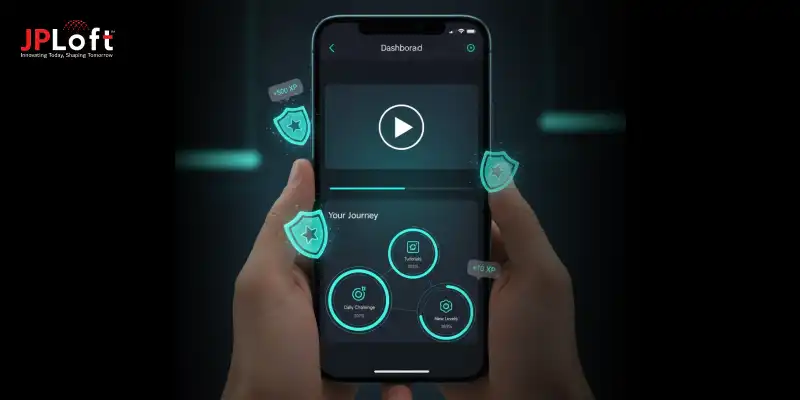Planning to launch your own video streaming app like Netflix? Sounds exciting, but not many apps actually succeed in the real world.
Why video streaming app fails isn’t just a question; it’s a reality for many startups. From confusing interfaces to poor content strategy, video streaming app failures happen more often than you’d think.
And it’s not just limited to on-demand platforms, live streaming app failure is also a common story in today’s crowded market. But don’t worry, you’re here to learn what not to do in your video streaming app, and that’s the first smart move.
Let’s break it all down, step by step.
Understanding the Video Streaming Apps
If you want to start an online video streaming business, here’s what you need to know. What exactly is a video streaming app?
So, it’s a platform that allows users to watch videos online without downloading them. Whether it's movies, TV shows, live sports, or tutorials, everything is played in real-time through an internet connection.
Apps like Netflix, YouTube, or even live streaming platforms like Twitch have set the bar high in this space. These apps work by storing video files on servers and delivering them in short sections to your device as you watch. This process is called “streaming.” Pretty cool, right?
But while the concept sounds simple, building one is far from easy. What kills most video streaming startups in early stages? It's usually not just one thing, but a mix of poor planning, weak tech setup, or lack of audience understanding.
These are some of the top reasons why a video streaming app fails and they directly answer the big question: Why Video Streaming App Fails?
But the market statistics shows us that all the challenges of video streaming apps can’t stop the development of the app because of the booming industry. Let’s take a short glance at it.
Market Statistics of Video Streaming Apps
Before diving into why a video streaming app fails, it’s important to understand how massive and fast-evolving this industry has become. With rapid growth and changing trends in video streaming apps, staying relevant and competitive is more challenging than ever.
Let’s discuss it in detail:
-
According to Grand View Research, the global video streaming market was valued at approximately $106.83 billion in 2023 and is expected to grow at a CAGR of 21.5% from 2024 to 2030.
-
A report by Business of Apps highlights that the industry generated nearly $200 billion in 2023, marking a 14% increase compared to the previous year, reflecting the rising demand for digital content consumption.
-
With consumers increasingly shifting from traditional TV to on-demand video platforms, the need for feature-rich, scalable, and user-friendly streaming apps has never been greater.
-
Meanwhile, Market Insights reports that the live streaming market, a fast-growing segment within the industry, was valued at $104.9 billion in 2024 and is projected to reach $712.9 billion by 2033, growing at a CAGR of 23.2%.
-
Emerging technologies like AI-powered recommendations, 5G connectivity, and cloud-based infrastructure are playing a major role in enhancing user experience and redefining engagement across streaming platforms.
The numbers clearly show that the opportunity is huge, but while the market potential is massive, not every app makes it. In fact, many promising platforms shut down within months of launch. So, what goes wrong?
Let’s dive into the top reasons why a video streaming app fails and how you can avoid making the same mistakes.
Why Does a Video Streaming App Fail?
Launching a video streaming app might sound like the perfect startup dream. With platforms like Netflix, Prime Video, and YouTube ruling the market, it feels tempting to join the race and create an app like Netflix to capture a piece of the growing demand.
But behind the glamour, there’s a tough truth many overlook: Why Video Streaming App Fails? The answer lies in multiple hidden challenges that are easy to miss but hard to fix once things go wrong.
Let’s explore the top reasons why a video streaming app fails and what you can do differently to make sure your app survives and grows.
1. Lack of Market Research
One of the biggest reasons why a video streaming app fails is launching a product without knowing who it’s for. Many startups skip user research, audience segmentation, or competitor analysis altogether.
As a result, they end up offering content that people don’t care about or building features that don’t solve any real problem. Every region, every niche, and every audience group has different needs. Some want educational videos, some prefer regional content, while others are looking for live shows or interactive experiences.
How to Avoid These Failures:
-
Begin with thorough market research to understand your audience.
-
Use tools like Google Trends, Reddit communities, and YouTube search data to discover what’s in demand.
-
Conduct interviews or surveys with real users to gather direct insights.
-
Analyze competitors and identify gaps in the best video streaming apps.
2. Poor Content Strategy
Let’s be honest, no one opens a streaming app to stare at a great UI. They come for the content. Yet, one of the most common video streaming app failures is a weak or inconsistent content strategy.
Many apps launch with just a few videos and expect users to keep coming back. But users expect variety, quality, and freshness. Without it, they leave fast.
How to Avoid These Failures:
-
Plan a consistent content flow well before launching the app.
-
Source a mix of original content, licensed shows, and user-generated videos to keep your library fresh.
-
Align your content with the target audience’s interests, language, and cultural preferences for better engagement.
-
Work with the best mobile app development company to ensure your content delivery system is optimized for speed, scalability, and seamless integration across devices.
3. Weak Monetization Plan
Why do Video Streaming startup apps fail? Because they don’t know how to make money. Many developers concentrate solely on building the app but neglect to define a clear business model.
It’s essential to decide whether you'll offer free content with ads, paid subscriptions, or a pay-per-view model. When your revenue model isn’t clear, users get confused, and your cash flow dries up. This often leads to early-stage video streaming startup failure.
How to Avoid These Failures:
-
From day one, plan how you’ll monetize a video streaming app based on your audience and content type.
-
Use freemium models for entertainment platforms to attract a wider user base.
-
Choose subscription-based models for premium or niche content with high value.
-
If you're unsure, test multiple monetization models during your MVP stage to see what works best.
4. Technical Glitches & Performance Failures
Slow load times, constant buffering, audio delays, or app crashes, these are the classic signs of video streaming app performance failures. No matter how great your content is, users will uninstall your app if it doesn’t run smoothly.
In a world where attention spans are short, even a few seconds of delay can lead to instant drop-offs. Seamless performance isn’t just a feature, it’s an expectation.
How to Avoid These Failures:
-
Build on a solid video streaming app tech stack that ensures fast content delivery and seamless performance.
-
Implement adaptive bitrate streaming to adjust video quality based on users’ internet speed.
-
Use CDNs (Content Delivery Networks) to minimize buffering and load times.
-
Test your app thoroughly across different devices, network conditions, and user scenarios before launch.
5. Complicated User Interface
Another major cause of video streaming app failure is a poor user interface. If users can’t find what they’re looking for within a few seconds, they leave. Confusing navigation, overwhelming layouts, and poor search functionality often frustrate users.
Even with great content, a bad user experience can drive people away before they even give the app a fair chance. In a competitive market, users expect ease, speed, and clarity from the very first tap.
How to Avoid These Failures:
-
Begin with detailed app wireframing to map out the user journey and screen layouts before development.
-
Create app prototypes to visualize and test how users will interact with each screen.
-
Focus on a clean, intuitive UI/UX design that offers smooth navigation and minimal clutter.
-
Use familiar layouts, smart content recommendations, and simple onboarding to improve user satisfaction.
6. Poor Scalability Planning
A lot of apps perform well during early app testing but crash during traffic spikes. This is especially true for live streaming app failures, where thousands of users may join simultaneously during an event.
If your infrastructure can’t handle sudden load, users face buffering, app crashes, or complete outages. These video streaming platform failures not only harm your reputation but also reduce trust and long-term retention.
Scalability isn’t just a back-end concern, it’s a user experience necessity from day one.
How to Avoid These Failures:
-
Make scalability a core part of your app’s architecture from the very beginning.
-
Use cloud infrastructure that can automatically scale based on user demand.
-
Opt for a microservices architecture instead of a monolithic build to allow flexible scaling and easier app maintenance.
-
Plan ahead for user growth and traffic spikes because once your app crashes, recovery isn’t always easy or guaranteed.
7. No Security Measures or Piracy Protection
In today’s environment, secure video streaming app development is not optional, it's a necessity. If your platform leaks user data or if your premium content gets pirated, you risk both financial loss and legal trouble.
Unfortunately, many startups overlook security of the app until it’s too late, leading to trust issues and user drop-offs. Robust security isn’t just a feature, it’s a foundation for platform credibility and long-term success.
How to Avoid These Failures:
-
Implement strong encryption to safeguard content and user data.
-
Use token-based authentication to secure user access and prevent unauthorized usage.
-
Integrate DRM (Digital Rights Management) to protect premium or licensed video content.
-
Prioritize app security at every stage of development to protect users and gain their confidence.
8. Weak Marketing Strategy
A solid app with great content can still face video streaming platform failure if no one knows it exists. Marketing isn’t just a post-launch activity, it starts before your first line of code.
Without proper visibility and positioning, even the best features and content will go unnoticed. Consistent branding and pre-launch buzz are key to attracting your first wave of users.
How to Avoid These Failures:
-
Build an audience before launch through targeted awareness campaigns.
-
Offer early-access programs or beta invites to build exclusivity and word-of-mouth.
-
Create an app with a clear marketing plan built into your development timeline.
-
After launch, continue promotion via newsletters, social media, SEO blogs, and push notifications to retain and grow your user base.
9. Ignoring Feedback & Slow Updates
How do video streaming apps fail? One reason is ignoring user feedback. Maybe your app has a bug, missing features, or confusing navigation, but you never address it. Eventually, users quit.
In today's competitive landscape, users expect regular improvements and feel valued when their input is acknowledged. Failing to respond to their needs can lead to low retention and negative reviews.
How to Avoid These Failures:
-
Create a clear update roadmap with a long-term vision that includes regular updates and improvements.
-
Build a clear update roadmap to show users what’s coming next.
-
Use analytics tools to identify drop-off points and user behavior trends.
-
Roll out updates frequently, not just for bug fixes, but also to introduce new and improved video streaming app features that boost engagement and user satisfaction.
10. Running Out of Budget
Launching and scaling a streaming app is not cheap. From content licensing to cloud servers and marketing, it all adds up fast. Many founders underestimate the cost to build a video streaming app and burn through their budget before reaching profitability.
Without a clear financial plan, even promising apps can stall mid-development or struggle to stay online. Budget mismanagement is one of the most preventable yet damaging reasons why video streaming startups fail.
How to Avoid These Failures:
-
Set realistic budgets covering development, operations, content creation, and marketing.
-
Break your launch into phases, start with an MVP (Minimum Viable Product), then add advanced features over time.
-
Keep a financial buffer for unexpected costs or delays during development and scaling.
-
Plan app monetization early to start generating revenue as soon as possible and sustain long-term growth.
Now that we’ve broken down the reasons behind video streaming startup failure, you’re better equipped to build a platform that succeeds, not just survives.
Avoiding these common pitfalls gives you a strong head start in a highly competitive market.
Remember, success doesn’t just come from great ideas, it comes from smart execution and continuous improvement.
From Launch to Shutdown: Real Case Studies of Streaming App Failures
Still wondering why the video streaming app fails? Real-world stories often speak louder than theory. Here are five video streaming platforms that started strong but didn’t survive the race and here are the reasons behind their video streaming startup failure.
A] Justin.tv
Once a pioneer in live streaming, Justin.tv laid the groundwork for Twitch.
-
Reason for failure: Lack of focus and monetization strategy. It struggled to define its audience and platform purpose.
-
Lesson: A scattered vision is a major cause of video streaming app failure, especially in early growth stages.
B] Quibi
Backed by top Hollywood names, Quibi launched with big expectations.
-
Reason for failure: Poor timing (pandemic lockdowns), no social sharing, and misreading mobile content behavior.
-
Lesson: Misalignment with user habits is a key reason why video streaming startups fail, even with strong funding.
C] Shomi
A Canadian Netflix competitor launched by major cable companies.
-
Reason for failure: Late entry into the market, lack of original content, and low user interest.
-
Lesson: Entering a saturated market without innovation leads to video streaming platform failure.
D] Hooq
A Southeast Asian streaming app backed by Warner Bros and Sony.
-
Reason for failure: High operating costs, slow user growth, and weak monetization.
-
Lesson: Poor ROI and scaling challenges often trigger video streaming app launch failure.
E] Seeso
A comedy-focused streaming service owned by NBCUniversal.
-
Reason for failure: Limited content, low visibility, and weak marketing strategy.
-
Lesson: Even niche platforms fail without strong user acquisition and engagement plans.
These case studies reveal that the top reasons why a video streaming app fails often lie in missed strategy, poor execution, or lack of adaptability in a competitive market.
Predict, Personalize & Perform: Why AI, ML & NLP Matter in Streaming App Success
One of the biggest reasons why video streaming apps fail is the lack of personalization and poor user engagement. That’s exactly where AI, ML, and NLP step in, not as add-ons, but as essentials.
With the help of an expert AI development service, your app can analyze user behavior in real time. AI helps predict what users want to watch next based on their habits, viewing patterns, and preferences. This leads to smarter recommendations, which significantly improve retention and satisfaction.
Pair that with a solid ML development service, and your platform can dynamically adapt to user needs, learning from actions like skips, replays, and watch duration. Machine Learning models fine-tune the content flow, making the app feel more intuitive with every session.
Now, enter NLP (Natural Language Processing), this is the key to intelligent search. By using a professional NLP development service, your app can understand voice commands, context-based queries, and even user sentiment.
This eliminates frustrating search experiences and boosts accessibility, especially on smart TVs and mobile devices. Together, these technologies not only enhance the user experience but also reduce churn, improve engagement, and help you avoid common video streaming app failures.
In today’s competitive landscape, leveraging AI, ML, and NLP isn’t just an upgrade, it’s a survival strategy.
Turn Your Video Streaming Vision into Reality with JPLoft
Want to break into the streaming industry with confidence? JPLoft is your go-to video streaming app development company for building scalable, secure, and feature-rich platforms.
We don’t just develop apps, we craft high-performing streaming experiences designed to grow with your audience and evolve with market demands. Whether you're building a broad entertainment service or a niche streaming platform, we deliver secure, user-friendly, and future-ready solutions tailored to your vision.
From MVP to full-scale product, our team handles everything, design, development, deployment, and support. With deep expertise in tech, user behavior, and content flow, we help you launch smarter and stream stronger.
Let’s build something your users can’t stop watching.
Final Wrap-Up
So, why video streaming app fails? It’s not just about poor content or bugs, it’s a mix of unclear strategy, technical issues, weak marketing, and lack of user focus. From app performance to monetization and scalability, every detail matters. But the good news is these failures are avoidable.
With the right approach, planning, and expert support, your app can not only survive, but thrive in this highly competitive space.
If you're serious about success, avoid the common pitfalls and focus on building a secure, user-friendly, and growth-ready streaming platform.
FAQs
Lack of unique content, poor scalability, security issues, weak marketing, and unclear monetization strategies are major reasons.
Offer high-quality content, personalized recommendations using AI/ML, and a clean, intuitive user experience.
Use a robust tech stack including adaptive bitrate streaming, cloud infrastructure, AI/ML algorithms, and secure payment gateways.
Yes, even with great design and features, users will leave if your app lacks engaging and regularly updated content.
Work with experts to build a scalable infrastructure, test under load, and integrate cloud-based auto-scaling solutions.













Share this blog